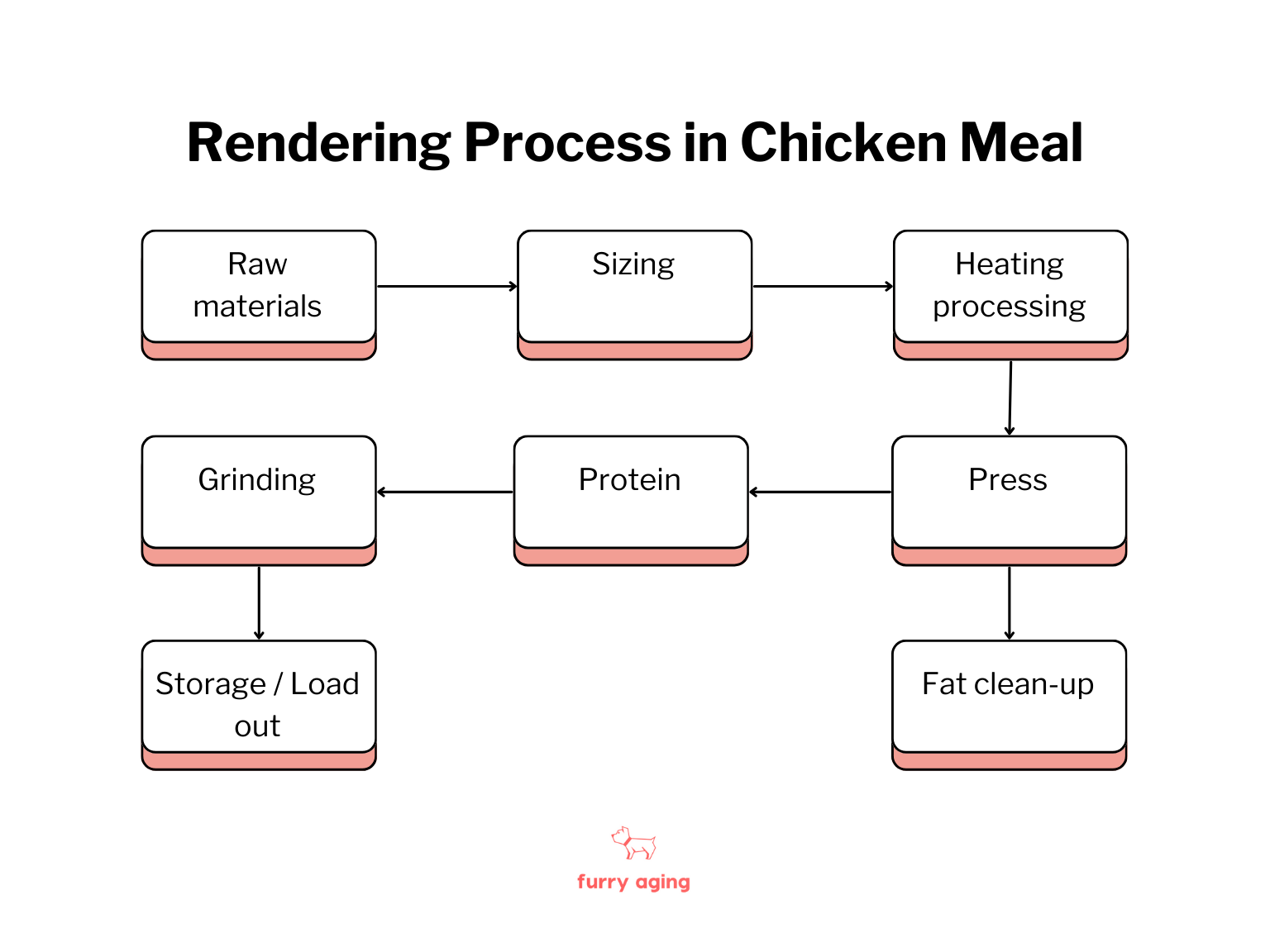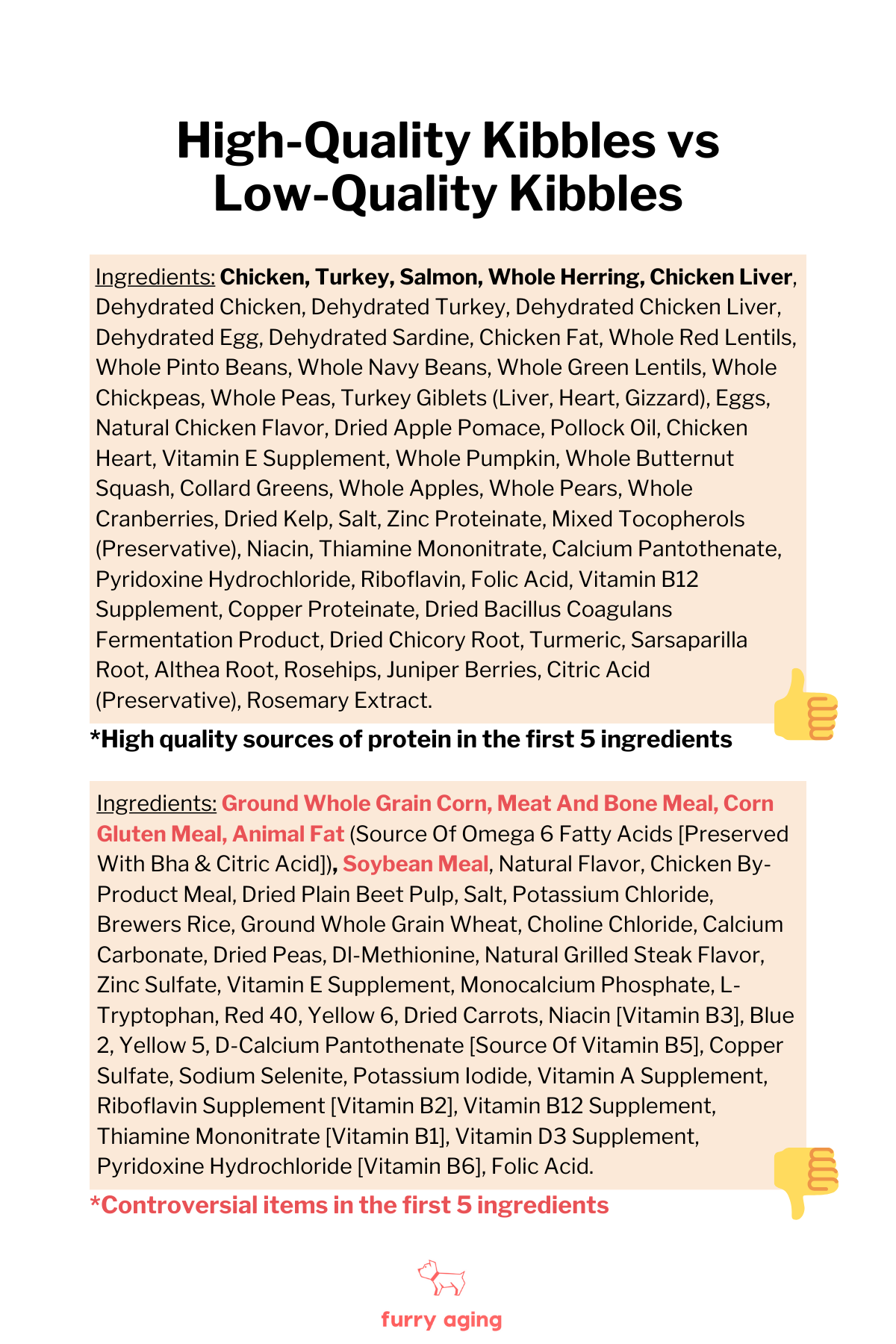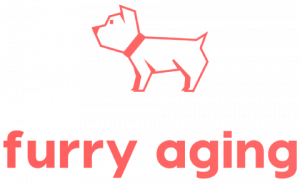Chicken meal is a common ingredient found in dog dry food that is made of a combination of chicken meat, skin, and some bones. They are ground and cooked at high temperatures for long periods of time. The result is a powder similar to the texture of cornmeal that contains a high percentage of protein.
However, as with many other processed foods, chicken meal also has disadvantages.
I spent quite some time researching this topic because there were many factors to consider, but also because many industry terms are confusing. I can say now that I have a solid understanding of what it is, the pros and cons. So let me break it down for you.
What is Chicken Meal Made of?
According to the AAFCO (Organization that regulates pet food companies), chicken meal follows the definition of:
“Poultry Meal is the dry rendered product from a combination of clean flesh and skin with or without accompanying bone, derived from the parts or whole carcasses of poultry or a combination thereof, exclusive of feathers, heads, feet, and entrails.”
This means that it is made of real chicken but not entirely from muscle, instead contains some other parts that are typically discarded for human consumption– for instance, neck and back. However, it does not contain feathers or beaks, as many critics I found online suggest.
The other important part to explain is the production process. The ingredients undergo a cooking process known as rendering, which involves grinding, and cooking them at high temperatures (approx. 284F) for long periods. Followed by pressing them to remove the fat and moisture. It is important to understand this process because later we will explain how impacts the nutritional value.

Source: An overview of the rendering industry
Is Chicken Meal Okay for Dogs?
Well, chicken meal is not bad per se. It provides nutritional value more cost-effectively, and that is the main reason why pet food companies include it in their recipes. The problem that I see is the lack of control that the buyer has over the quality of ingredients and processes. You could potentially reduce these risks by choosing brands that are more transparent with their manufacturing practices and sourcing.
But to answer this question better, let’s dive into the pros and cons.
Pros of Chicken Meal
👍High in Protein:
If you compare chicken meal to real chicken by weight, you’ll notice that chicken meal contains 75% protein, while real chicken contains only up to 15%. The reason for this is that during the rendering process, all moisture is extracted, resulting in a highly concentrated protein powder.
👍Source of Glucosamine:
Chicken meal is also a natural source of glucosamine, which promotes healthy joints, and reduces inflammation.
👍Budget-friendly:
The ingredient is cheaper than fresh chicken, and easier to store and transport, which makes it overall a more cost-effective option for pet food manufacturers, and therefore more affordable for the buyer.
Cons of Chicken Meal
👎Quality of Ingredients:
The ingredients used to produce chicken meal are not considered “human-grade”, meaning they are not safe enough for human consumption. Some reputable brands may still have strict sourcing controls to not compromise your pet’s health, however, other brands may use ingredients sourced from 4D meat. This is an industry term to refer to meat coming from dead, dying, diseased, or disabled animals, and with that comes the risk of containing pharmaceutical products used to treat sick animals.
👎Variability in Protein Quality:
One of the ratios used to measure the quality of protein in ingredients is the Protein Efficiency Ratio (PER). A higher PER means better protein quality. In a study comparing different rendered chicken parts used to produce meal and by-meal products in pet foods, chicken feet had the lowest PER at 0.87, followed by bones at 1.22. Internal organs had a PER of 3.04, while gizzards, liver, and hearts had a PER of 3.08. The highest PER of 3.43 was found in chicken meant for human consumption. This proves that higher protein doesn’t necessarily mean better nutrition.
And, since the individual ingredients used to produce chicken meal can vary from batch to batch and supplier to supplier, you can’t predict the protein quality.
👎Process Quality Control:
As we explained before, the process of producing chicken meal involves cooking at high temperatures for long periods. When temperature and time aren’t set exactly, the protein digestibility of amino acids is affected (bear with me here. We’ll talk more about digestibility in a second). The issue is that not all brands have strict protocols and offer visibility over them.
What is Digestibility?
Digestibility is the proportion of food that a dog’s digestive system is able to break down and absorb into their body. It’s measured by nutrients absorbed to nutrients consumed and is one of the key factors in determining the quality of the food.
The food’s digestibility impacts your dog’s overall health, and their bowel movement (in other words, how much they poop, how it looks and smells 💩)
It is typically determined through feeding trials, where researchers analyze the nutrients present in the dog’s stool and compare them to the nutrients in the food they consume. Pet food companies run these tests all the time, unfortunately, they are not required to disclose this information to consumers.
Some independent studies have shed some light on the digestibility of chicken meal. These suggest that chicken meal has a moderate digestibility rate of 80.2%. For comparison, lamb meal has a poor digestibility rate of 71.5%, while fish meal has a high digestibility rate of 87.0%. But, as we know, this ratio can decrease due to poor quality control of the production processes.
In case you are wondering, they also measured the digestibility of fresh chicken, which was considered high with a rate of 88.2%. Interestingly, when raw chicken replaces 25% of the poultry meal in an extruded dry food, the digestibility rate decreases significantly to 81.3%, which is not much better than chicken meal.
Chicken vs. Chicken Meal
When you come across “fresh chicken” or “chicken” in the list of ingredients, it means that the recipe includes chicken flesh, skin, and some bones (unless listed as deboned chicken). These are parts that may look similar to the chicken you find in the grocery aisle or could be less appealing parts for humans, such as back and necks that are also used in chicken meal. The chicken parts are just cooked as someone would do for human consumption to destroy any harmful bacteria.
And, when you see “chicken meal” means that these same ingredients have passed through a rendering process, which– in case you forgot, is the process of cooking them at very high temperatures for a long time.
Now, which one is better and why? 🤔
In terms of nutritional value, chicken meal is higher in protein and has less fat.
And in terms of digestibility, fresh chicken used as a source of protein in kibbles has a similar ratio to chicken meal. It sounds counterintuitive, right? However, the hypothesis is that fresh ingredients are more susceptible to damage during the extrusion process to prepare the kibbles.
If we talk about “fresh chicken” in whole food diets, then it is 100% better than chicken meal because it is not processed, and has higher quality protein. Even better if it is listed as “human-grade” chicken.
Is Chicken Meal Better Than Chicken By-Products Meal?
“Chicken by-product meal” is another common ingredient found in dog food. Both “chicken meal” and “by-product meal” undergo similar cooking processes, however, the difference comes from the ingredients used.
Chicken meal is made from a combination of clean flesh, skin, and bones, while chicken by-products meal is made of organs, undeveloped eggs, heads, necks, and feet.
Pet nutritionists recommend avoiding by-product meal because the ingredients are of much lower quality, with higher variability in process control and nutritional quality.
What Ingredients Should I Choose When Buying Kibbles?
Pet food brands list their ingredients in order of quantity, and typically the first 5 ingredients are the most important as they may represent 80% of the bag. So, the next time you are browsing for kibbles, check the first 5 ingredients and prioritize those recipes that state the protein source such as chicken, chicken liver, salmon, eggs, etc. Avoid recipes that list “by-products meals”.

Chicken in Dog Food: Quality Options
- Baked chicken with carrots by Ollie (Baked)
- Fresh chicken dish with carrots by Ollie (Fresh)
- Chicken recipe by The Farmer’s Dog (Fresh)
- Chicken cuisine by Nom Nom (Fresh)
- Chicken + brown rice Unkibble by Spot & Tango (Dry)
- Orijen Original grain-free (Dry)
Final Thoughts
Writing this article took me more than I expected because once I started unraveling the information, I found confusing and contradictory sources. That being said, it’s extremely important to know what you’re feeding your dogs to ensure their well-being.
When it comes to chicken meal in dog food, it’s an affordable option, but it raises concerns about the quality of ingredients and the manufacturing process. If you can opt for a fresh diet with whole and human-grade ingredients, that’s the path most nutritionists would advise.
However, if that is not within your possibilities, choose brands that are transparent about their ingredients and processes to improve your pet’s overall nutrition. Understanding the pros and cons helps make informed decisions when selecting dog food for your furry companion.
🐶😋🐔
References:
- Digestibility Matters
- Poultry Meal vs Poultry by-products meal
- What’s in the Ingredients List? Association of American Feed Control Officials (AAFCO)
Related Articles:
Recent Posts
What Your Dog's Poop Reveals (Healthy Poops and Warning Signs)
An unusual poop could be concerning but does not necessarily mean our dog is in danger or sick. Especially, if they are otherwise behaving normally and not showing any signs of pain. I still...
I recently learned that AI can predict kidney diseases in pets that will occur two years from now with high accuracy, and this got me thinking if it could have changed my dog's fate. Could we have...
